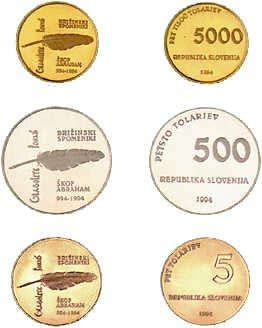1000 years anniversary of the death of Bishop Abraham, connected with the Freising manuscripts (1994)

The Freising Manuscripts are the first Roman-script record of any Slavonic language. They consist of three texts in the oldest Slovene, bound into a Latin Codex (manuscript book) from Freising in Bavaria. Four parchment leafs and a quarter of a page have been preserved. Linguistic, stylistic and contextual analyses reveal that these are church texts of careful composition and literary form.
The precise date of the origin of the Freising Manuscripts cannot be determined; the original text was probably written in the 9th century. They were discovered in 1807 in the Munich National Library during the examination of the manuscripts from Freising near Munich, which was once the centre of a diocese.
Bishop Abraham was active (from 957) in Freising during the time of the writing of the two manuscripts (sermons on sin and repentance, a confessional form), and also acquired a large estate of land in the Creina province around Škofja Loka. For this reason some linguists (e.g. Jernej Kopitar and Rajko Nahtigal) linked him closely to the origin of the Freising Manuscripts and, without any firm evidence, attributed him as being the author of one of the texts and suspected that he was of Slovene origin. Bishop Abraham died 1000 years ago, on 26 May 994.
The Freising Manuscripts are evidence of the thousand-year presence of the Slovenes in Europe. They are preserved in the Bavarian State Library in Munich.
To mark the thousand-year anniversary of the death of Bishop Abraham, linked to the Freising Manuscripts, the Republic of Slovenia is issuing three commemorative coins. On these coins, using the original script, are imprinted the words "Glagolite ponaz" with which the first Freising Manuscript begins.
- a gold coin with a nominal value of 5000 Tolars, a weight of 7 grams, a diameter of 24 mm and a purity of 900/1000; in a quantity 1,000 coins;
- a silver coin with a nominal value of 500 Tolars, a weight of 15 grams, a diameter of 32 mm and a purity of 925/1000; in a quantity of 3,000 coins;
- a coin for general circulation with a nominal value of 5 Tolars, a weight of 6.4 grams, a diameter of 26 mm, made of an Cu-Zn-Ni alloy; quantity: 200,000 pieces.
Authors of the rough-cast design: Gorazd and Matjaz Ucakar, Ljubljana
Minting of gold coins: International Company Zlatarna Celje, Celje / Slovenia
Minting of silver and circulation coins: Statna Mincovna, Kremnica / Slovakia

